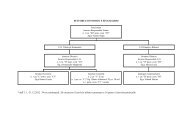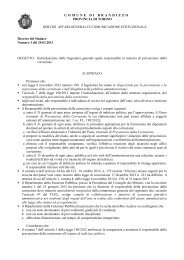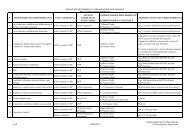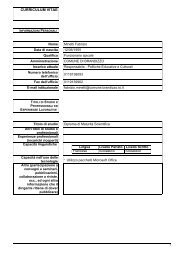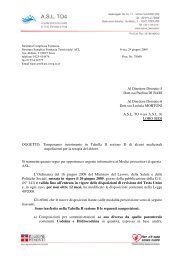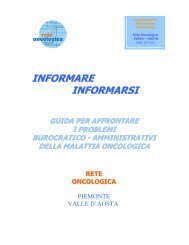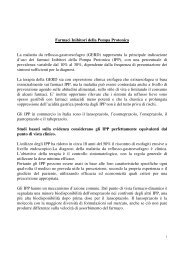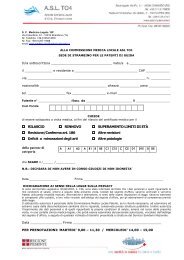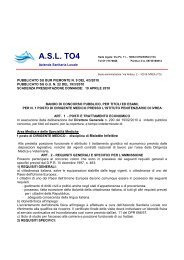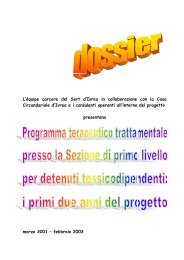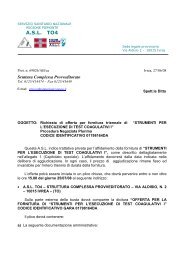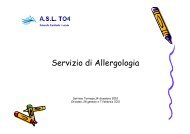Articolo sulla casistica delle non idoneità allo sport agonistico in ...
Articolo sulla casistica delle non idoneità allo sport agonistico in ...
Articolo sulla casistica delle non idoneità allo sport agonistico in ...
Create successful ePaper yourself
Turn your PDF publications into a flip-book with our unique Google optimized e-Paper software.
BODY EQUILIBRIUM AND CONNECTIVE TISSUE GALLOZZI<br />
chemical modifications: for example, <strong>in</strong> bone,<br />
the osteoclasts cannot reabsorb piezoelectrically<br />
loaded bone.<br />
The ECM also supplies the chemical and physical<br />
environment for the cells it enfolds, form<strong>in</strong>g<br />
a structure to which they adhere and with<strong>in</strong> which<br />
they can move, ma<strong>in</strong>ta<strong>in</strong><strong>in</strong>g a suitable hydrated<br />
and permeable ionic environment through which<br />
metabolites are diffused. The density of the<br />
fibrous matrix and the viscosity of the fundamental<br />
substance determ<strong>in</strong>e the free flow of<br />
chemical substances between cells, at the same<br />
time prevent<strong>in</strong>g the penetration of bacteria and<br />
<strong>in</strong>ert particles. Local “obstructions”, such as fascial<br />
adherences deriv<strong>in</strong>g from excessive effort,<br />
hypok<strong>in</strong>esia, traumas etc. can create an impediment<br />
to the correct flow of chemical substances,<br />
modify<strong>in</strong>g the metabolism of the cells of the tissues<br />
concerned.<br />
The connectival fascia<br />
The fascia is a network of f<strong>in</strong>e connective tissue<br />
that is arranged <strong>in</strong> cont<strong>in</strong>uous layers throughout<br />
the body. The muscles and bones are organised<br />
and susta<strong>in</strong>ed by this network as are all the<br />
elements mak<strong>in</strong>g up the human body.<br />
In particular the muscles are wrapped <strong>in</strong> the<br />
fascia but every s<strong>in</strong>gle fibre and each of the sp<strong>in</strong>dles<br />
are too (myofascia). The def<strong>in</strong>ition of movement<br />
cannot therefore be limited strictly to muscular<br />
action, but must be extended to a comb<strong>in</strong>ed,<br />
<strong>in</strong>separable action between the muscles<br />
and their sheathes. The fascial lam<strong>in</strong>ae <strong>in</strong> fact<br />
also penetrate its most elementary structures, like<br />
the fibres and myofibrils. They thus form a k<strong>in</strong>d<br />
of framework <strong>in</strong> which every myofibril can contract<br />
longitud<strong>in</strong>ally and expand transversally. If we<br />
consider that there is cont<strong>in</strong>uity <strong>in</strong> the connective<br />
tissue that only changes its form between muscle,<br />
tendon and periostium, muscular action is transmitted<br />
throughout the bone, so generat<strong>in</strong>g movement.<br />
But the fascia is someth<strong>in</strong>g else, it is not only<br />
a conta<strong>in</strong>er. It has some very important elements<br />
with<strong>in</strong> it that are to some extent correlated with<br />
the state of general balance and about which we<br />
still do not have full knowledge.<br />
It should be stressed that the fascial system is<br />
seamless and is therefore the only anatomical element<br />
that puts <strong>in</strong>to contact (and <strong>in</strong>to communication)<br />
all the organs and systems <strong>in</strong> our body.<br />
paragrafo precedente): qualunque forza meccanica<br />
che crea deformazione strutturale stira i legami<br />
<strong>in</strong>termolecolari producendo un leggero flusso elettrico.<br />
Questa carica può essere rilevata dalle cellule<br />
e comportare modifiche biochimiche: ad esempio,<br />
nell’osso, gli osteoclasti <strong>non</strong> possono riassorbire<br />
osso piezoelettricamente carico.<br />
La MEC fornisce anche l’ambiente chimico-fisico<br />
per le cellule che avvolge, formando una struttura<br />
a cui queste aderiscono e dentro la quale possono<br />
muoversi, mantenendo un adatto ambiente ionico<br />
idratato e permeabile, attraverso il quale diffondono<br />
i metaboliti. La densità della matrice fibrosa e la<br />
viscosità della sostanza fondamentale determ<strong>in</strong>ano<br />
il libero flusso <strong>delle</strong> sostanze chimiche fra cellule,<br />
impedendo <strong>allo</strong> stesso tempo la penetrazione di batteri<br />
e particelle <strong>in</strong>erti. "Ostruzioni" locali, come le<br />
aderenze fasciali derivanti da sforzi eccessivi, da ipoc<strong>in</strong>esia,<br />
traumi ecc, possono creare impedimento<br />
al corretto flusso <strong>delle</strong> sostanze chimiche alterando<br />
il metabolismo <strong>delle</strong> cellule dei tessuti <strong>in</strong>teressati.<br />
La fascia connettivale<br />
La fascia è una rete di sottile tessuto connettivale<br />
che si dispone <strong>in</strong> strati cont<strong>in</strong>ui <strong>in</strong> tutto il corpo.<br />
I muscoli e le ossa sono organizzati e sostenuti da<br />
questa rete, come pure tutti gli elementi che costituiscono<br />
il corpo umano.<br />
In particolare i muscoli sono avvolti nella fascia,<br />
ma lo è anche ogni s<strong>in</strong>gola fibra e ognuno dei fusi<br />
(MIOFASCIA). Non si può, qu<strong>in</strong>di, limitare la def<strong>in</strong>izione<br />
di movimento marcatamente all’azione<br />
muscolare, ma a un’azione comb<strong>in</strong>ata e <strong>in</strong>separabile<br />
tra i muscoli e le loro fasce. Le lam<strong>in</strong>e fasciali<br />
penetrano <strong>in</strong>fatti anche nelle sue strutture più<br />
elementari, come le fibre e le miofibrille. Formano<br />
così una specie di impalcatura, nella quale ogni<br />
miofibrilla può contrarsi longitud<strong>in</strong>almente ed<br />
espandersi <strong>in</strong> modo trasversale. Se si considera che<br />
c’è cont<strong>in</strong>uità nel tessuto connettivo che cambia<br />
solo la sua forma, tra muscolo, tend<strong>in</strong>e e periostio,<br />
l’azione muscolare viene trasmessa <strong>in</strong> modo articolato<br />
sull’osso, generando così il movimento.<br />
Ma la fascia è un qualcosa di più, <strong>non</strong> è soltanto<br />
un contenitore, ha degli elementi al suo <strong>in</strong>terno<br />
molto importanti che sono <strong>in</strong> qualche modo correlati<br />
con lo stato di equilibrio generale e di cui mancano<br />
ancora conoscenze complete.<br />
Va sottol<strong>in</strong>eato che il sistema fasciale <strong>non</strong> ha<br />
soluzioni di cont<strong>in</strong>uità ed è qu<strong>in</strong>di l’unico elemento<br />
anatomico che mette <strong>in</strong> contatto (ed <strong>in</strong> comunicazione)<br />
tutti gli organi ed apparati del nostro corpo.<br />
Le nuove tecniche dell’anatomia, hanno permesso<br />
di focalizzare la ricerca su dettagli anato-<br />
Vol. 62, N. 4 MEDICINA DELLO SPORT 397



